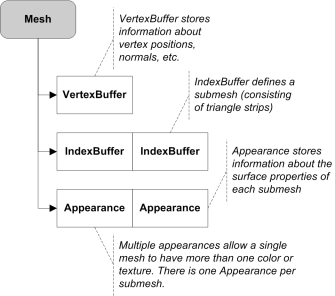 javax.microedition.m3g.Object3D
javax.microedition.m3g.Object3D
 javax.microedition.m3g.Transformable
javax.microedition.m3g.Transformable
 javax.microedition.m3g.Node
javax.microedition.m3g.Node
 javax.microedition.m3g.Mesh
javax.microedition.m3g.Mesh
|
M3G 1.1 -- Jun 22, 2005 | |||||||||
| PREV CLASS NEXT CLASS | FRAMES NO FRAMES | |||||||||
| SUMMARY: NESTED | FIELD | CONSTR | METHOD | DETAIL: FIELD | CONSTR | METHOD | |||||||||
java.lang.Objectjavax.microedition.m3g.Object3D
javax.microedition.m3g.Transformable
javax.microedition.m3g.Node
javax.microedition.m3g.Mesh
A scene graph node that represents a 3D object defined as a polygonal surface.
This class represents a conventional rigid body mesh, while the derived classes MorphingMesh and SkinnedMesh extend it with capabilities to transform vertices independently of each other. The structure of a basic Mesh is shown in the figure below.

A Mesh is composed of one or more submeshes and their associated Appearances. A submesh is an array of triangle strips defined by an IndexBuffer object. The triangle strips are formed by indexing the vertex coordinates and other vertex attributes in an associated VertexBuffer. All submeshes in a Mesh share the same VertexBuffer. However, in the case of a MorphingMesh, a weighted linear combination of multiple VertexBuffers is used in place of a single VertexBuffer.
Submeshes within a Mesh are rendered in the order of ascending
Appearance layers, and such that opaque submeshes are rendered before
transparent submeshes on the same layer. See the setLayer method in Appearance for more
discussion on layered rendering.
Rendering and picking of a submesh is disabled if its Appearance is null.
An exception is thrown if the VertexBuffer or any of the IndexBuffers are in an invalid state when rendering or picking; see the respective class descriptions for more information. Note that it would be useless to check for these exception cases at construction time, because the application may freely change the contents of a VertexBuffer or an Appearance at any time. However, null IndexBuffers and VertexBuffers are blocked at the constructor, as usual, because the application is not able to change them afterwards.
VertexBuffer,
IndexBuffer| Field Summary |
| Fields inherited from class javax.microedition.m3g.Node |
NONE, ORIGIN, X_AXIS, Y_AXIS, Z_AXIS |
| Constructor Summary | |
Mesh(VertexBuffer vertices,
IndexBuffer[] submeshes,
Appearance[] appearances)
Constructs a new Mesh with the given VertexBuffer and submeshes. |
|
Mesh(VertexBuffer vertices,
IndexBuffer submesh,
Appearance appearance)
Constructs a new Mesh consisting of only one submesh. |
|
| Method Summary | |
Appearance |
getAppearance(int index)
Gets the current Appearance of the specified submesh. |
IndexBuffer |
getIndexBuffer(int index)
Retrieves the submesh at the given index. |
int |
getSubmeshCount()
Gets the number of submeshes in this Mesh. |
VertexBuffer |
getVertexBuffer()
Gets the vertex buffer of this Mesh. |
void |
setAppearance(int index,
Appearance appearance)
Sets the Appearance for the specified submesh. |
| Methods inherited from class javax.microedition.m3g.Node |
align, getAlignmentReference, getAlignmentTarget, getAlphaFactor, getParent, getScope, getTransformTo, isPickingEnabled, isRenderingEnabled, setAlignment, setAlphaFactor, setPickingEnable, setRenderingEnable, setScope |
| Methods inherited from class javax.microedition.m3g.Transformable |
getCompositeTransform, getOrientation, getScale, getTransform, getTranslation, postRotate, preRotate, scale, setOrientation, setScale, setTransform, setTranslation, translate |
| Methods inherited from class javax.microedition.m3g.Object3D |
addAnimationTrack, animate, duplicate, find, getAnimationTrack, getAnimationTrackCount, getReferences, getUserID, getUserObject, removeAnimationTrack, setUserID, setUserObject |
| Constructor Detail |
public Mesh(VertexBuffer vertices,
IndexBuffer submesh,
Appearance appearance)
Constructs a new Mesh consisting of only one submesh. Rendering and picking of the Mesh is initially disabled if the Appearance is set to null.
vertices - a VertexBuffer to use for this meshsubmesh - an IndexBuffer defining the triangle strips to drawappearance - an Appearance to use for this mesh, or null
java.lang.NullPointerException - if vertices is null
java.lang.NullPointerException - if submesh is null
public Mesh(VertexBuffer vertices,
IndexBuffer[] submeshes,
Appearance[] appearances)
Constructs a new Mesh with the given VertexBuffer and submeshes.
The number of submeshes is set equal to the length of the
submeshes array. The appearances array
is parallel to that, and must have at least as many elements. A
null Appearance disables rendering and picking of the corresponding
submesh. If the array itself is null, all appearances are initialized
to null.
vertices - a VertexBuffer to use for all submeshes in this meshsubmeshes - an IndexBuffer array defining the submeshes to drawappearances - an Appearance array parallel to
submeshes, or null
java.lang.NullPointerException - if vertices is null
java.lang.NullPointerException - if submeshes is null
java.lang.NullPointerException - if any element in submeshes
is null
java.lang.IllegalArgumentException - if submeshes is empty
java.lang.IllegalArgumentException - if (appearances != null) && (appearances.length <
submeshes.length)| Method Detail |
public void setAppearance(int index,
Appearance appearance)
Sets the Appearance for the specified submesh.
index - index of the submesh to set the Appearance ofappearance - Appearance to set for the submesh at
index, or null to disable the submesh
java.lang.IndexOutOfBoundsException - if (index < 0) ||
(index >= getSubmeshCount)getAppearancepublic Appearance getAppearance(int index)
Gets the current Appearance of the specified submesh.
index - index of the submesh to get the Appearance of
index
java.lang.IndexOutOfBoundsException - if (index < 0) ||
(index >= getSubmeshCount)setAppearancepublic IndexBuffer getIndexBuffer(int index)
Retrieves the submesh at the given index.
index - index of the submesh to get
index
java.lang.IndexOutOfBoundsException - if (index < 0) ||
(index >= getSubmeshCount)public VertexBuffer getVertexBuffer()
Gets the vertex buffer of this Mesh. This is always the original VertexBuffer that was supplied at construction. The VertexBuffer is never written to by the implementation. Specifically, the results of morphing (MorphingMesh) and skinning (SkinnedMesh) are not written to the VertexBuffer, nor are they exposed to the application by any other means.
In the case of a MorphingMesh, this VertexBuffer represents the base
mesh. The morph target VertexBuffers can be retrieved with the getMorphTarget method in MorphingMesh.
public int getSubmeshCount()
Gets the number of submeshes in this Mesh. This is always at least 1.
|
M3G 1.1 -- Jun 22, 2005 | |||||||||
| PREV CLASS NEXT CLASS | FRAMES NO FRAMES | |||||||||
| SUMMARY: NESTED | FIELD | CONSTR | METHOD | DETAIL: FIELD | CONSTR | METHOD | |||||||||